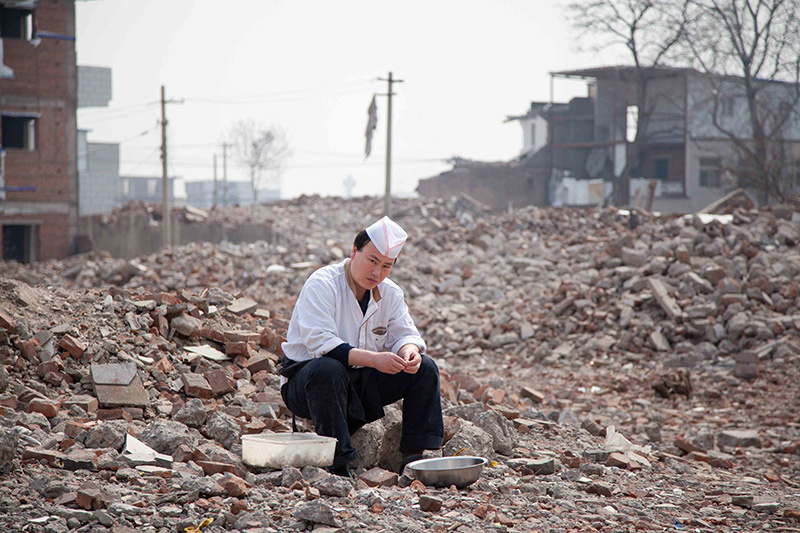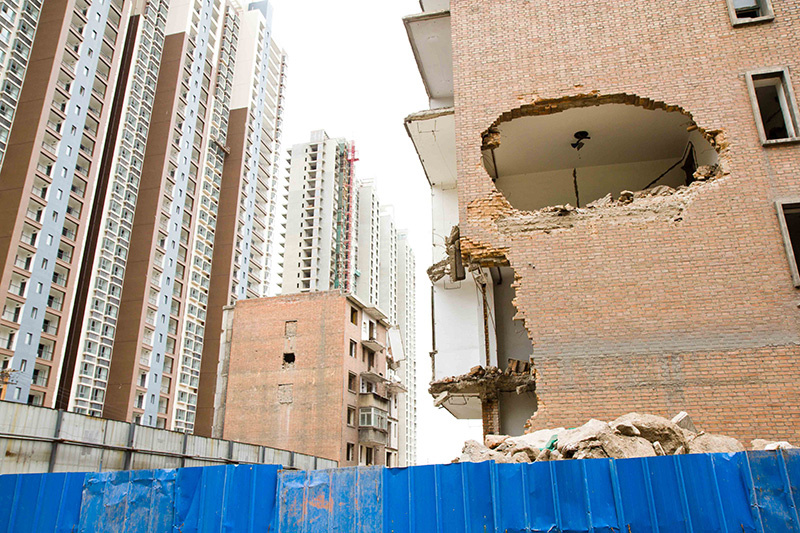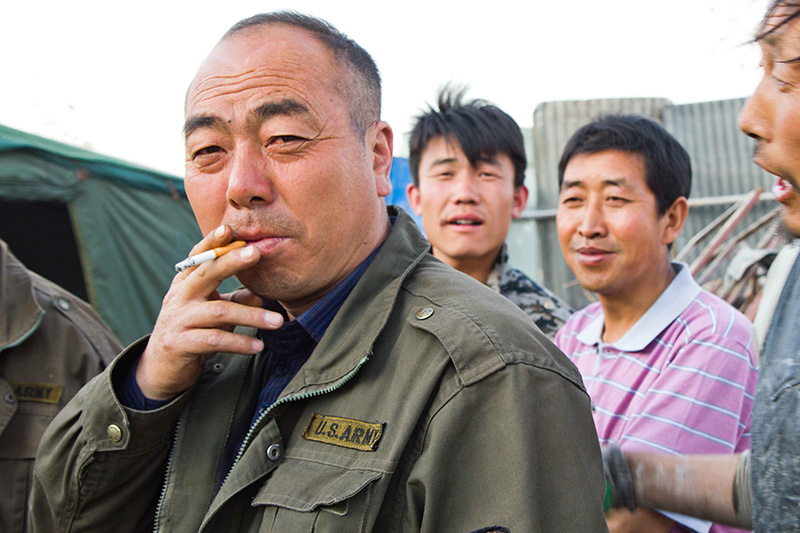China’s cities are strewn with hidden rubble fields, vast apocalyptic landscapes that terminate abruptly at the thresholds of bustling neighborhoods. The skeletons of houses show what once existed there. Onlookers say it resembles the aftermath of a bombing raid—and it does, except bombs aren’t this precise. The damage here obeys strict geometries. You can fill a wheelbarrow with what’s left of a house on this side of the road, while a house on that side stands without a scratch.
Advertisement
Before any of the damage occurs, walls are erected to partition a neighborhood. The message of the walls is unmistakable: everything enclosed will be destroyed. A development company has claimed this land. Walls go up quickly—sometimes overnight. Often they are a resident’s first notification that eviction is just days away. The executives behind these maneuvers have studied their Sun Tzu, required reading at any decent business school. “Let your plans be dark and impenetrable as the night,” the Chinese Machiavelli writes in his masterpiece The Art of War, “and when you move, fall like a thunderbolt.” In other words, leave them as little time as possible to assemble their Molotov cocktails.Most residents take the standard submarket compensation for their homes and leave, but a few refuse, doggedly assembling barricades, stockpiling incendiary devices, and sharpening farming tools. Developers have a name for the houses of holdouts like this. They call them “nail houses”: as in stubborn nails embedded in wood that won’t be beaten down. A developer’s conventional response is simply to employ a bigger hammer. Hired thugs arrive promising violence, Cultural Revolution-style loudspeakers bark propaganda, utilities are cut, and construction begins on the adjacent land—as loudly as possible, and for 24 hours a day.

In the city of Chongqing back in 2004, developers were able to disperse all but two residents in a community of 280. When this recalcitrant husband and wife refused to leave, a three-year standoff ensued, attracting widespread media attention. Workers excavated the land around the couple’s house to a depth of 30 feet, leaving it perched precariously atop a mesa. The husband, a martial-arts master, threatened to give flying lessons to any of the goons sent to intimidate him and employed whirling nunchucks to carve a spiraling stairway up to their front door. Their nail house was finally hammered down in 2007, after the pair accepted an undisclosed settlement.
Advertisement
Most holdouts aren’t so lucky. The vast majority of these stalemates never make the papers, leaving developers free to use more extreme tactics. In his book, China in Ten Words, author Yu Hua gives an account of one such typical case.“A family of five was unable to reach agreement with the local authorities on compensation for the loss of their house… One night as they were sleeping, a gang of men in hard hats threw ladders up against the outside wall, smashed the windows with hammers and clubs, and jumped inside. The family awoke to find themselves surrounded by dozens of intruders. Before they were fully aware of what was happening, they were dragged from their beds like criminals and rushed downstairs… Any resistance was met with a punch in the jaw. They were shoved into a van and taken to an empty house… until noon that day, when an official came in and informed them that their house had been razed.”In another case, Yu describes bulldozers in formation ramming a home with a couple still inside. The husband and wife stood on their fourth-floor balcony drinking whiskey and hurling down Molotov cocktails on the demolition crew. The husband earned an eight-month prison sentence for “obstructing public works.”

I came to China on a tip given by a childhood friend who had been living in the country for several years. “I know you love broken-down buildings,” he wrote, “How about a thousand of them, one right after the other?” I had been photographing abandoned landscapes since adolescence, living near dying Detroit—that maligned place whose decay deconstructs modern life’s false promises of control, progress, and permanence. Its transience translates too easily: a Times Square reclaimed by wolves, an Eiffel Tower consumed by vines.
Advertisement
I bought a ticket to Shanghai soon after my friend’s letter came. It was early 2011. This would be the first of several similar excursions to the People’s Republic over the next two years.I had last been to China about a decade earlier. It was entirely different. I remembered endless bicycles and low apartment blocks. These days, cars and skyscrapers prevailed. Ten years ago, the only dogs I saw were playing dead on plates. Now, the animals sported fake-jewel collars and pranced on the ends of leashes.I noticed the ghettoizing walls immediately, scrolling past my taxi window. Decked in taut plastic signage, they were designed to be noticed. The signs advertised the new residential towers to be built on site. Images of willow-lined lakes, sultry Koi, and Europeans in top hats or powered wigs predominate in these kinds of signs. For additional prestige, cryptic English phrases are added: “A symbol of urban civilization,” “COLLECTION, RESPECT, AND DIALOGUE,” “Millenium Mansion for Aristocrat,” “An oriental era biography facing to the world,” “The delicate life,” “THE WORLD'S COVE.”

Walking along the Huangpu River that first morning, I found an open gate in one of the walls and went through, prepared to play the dumb foreigner if questioned. There was an expanse of barren earth surrounding what remained of a two-story apartment block—just the middle chunk was left. Its jagged brick edges showed where each flank of the building had been amputated. A couple of women hung laundry. A man washed his face outside in a basin, a sign that the water and electricity had been cut. These were the last defiers of an eviction order. As each neighbor had left, the developers had gouged out the vacated apartments, one by one—the standard practice. The length of the standoff could be measured by the height of a sapling that had rooted in one of the empty upper rooms. It poked out a window and fanned its canopy high above the shingles. I spoke little Mandarin so there was nothing much to say besides “Ni hao.” I set about photographing the area. Nobody seemed to care that I was there, except three little sons who dashed out, first to laugh, then to dance in closer and closer, and finally, to impishly pull out and wag their penises at me. When I returned to that lot a year later, there was nothing left of that house. Not a brick.
Advertisement
I spent the rest of my first day climbing through a jungle gym of ruins extending out from that place that I never saw the end of. After Shanghai came a string of other cities. I spent six weeks breathing dust in demolition sites across China, documenting a kind of natural history of these transitional scenes.After the walls went up, I noticed, the homes emptied fast and the neighborhoods became a kind of no man’s land for a while. The developers were quick to evict but often slow to demolish. There was still time for weeds to grow, for birds to build nests, for paint to peel, for lovers to tryst, for graffiti, for dead dogs to become bones, for kids to throw stones, for excrement to bleach white in the sun.

Scavengers would come almost immediately. They followed the demolition men like buzzards, hovering on the periphery, until the crews had left and a kind of race would begin. They hurried to remove the doors and windows, pipes and fittings, furniture, anything. Everything of value was carried off and what couldn’t be carried was dragged. The scavengers were the first to bring an order to the chaos. I’ve seen people do the same thing after natural disasters—taking comfort in the simple act of sorting. They made piles: brick beside brick, tile beside tile, glass beside glass. like beside like.I wandered through empty rooms with the wind. I photographed forgotten objects: a broken accordion, a three-legged chair, crumpled clothing, a red lace bra, a child's toy, a bamboo cane, dishes, scattered playing cards, a birdcage, rings, and pieces of things - unrecognizable, their meanings all carried away.
Advertisement
The buildings are changed into piles of rubble one by one. Not in any methodical way. A house here, a house there. One day a roof disappears and then nothing happens for weeks. A single hole is gouged in the side of an apartment block and a year passes. Mountains of rubble rise, fall, and shift position from day to day.I often came upon scenes of lonely houses in the midst of nothingness. For blocks in all directions, the land would be flat as a mahjong board after the remnants of a hundred buildings had been scraped away. Entrepreneurs were buying rubble by the trainload over in the eastern plains, I was told, to make mountains for ski resorts. There is something sadly dignified about a house that stands alone, especially if it’s an old one—a Qing Dynasty-era stone manor, for example. Voices would fly from its windows. Laundry would hang from its gate. I would wonder, why was this building left here standing alone, untouched, before the glacial wall of encroaching towers, all rising as fast as iron could be ripped from the earth? Most of the time there was a renegade family holed up inside, but other times the house had been commandeered to quarter demolition workers. I watched once, when after a final breakfast, a crew exited the manor they had been living in, bedrolls in hand. The men marched out, turned around, and tore that manor right down too. From habit, the last man out had closed the door.
Advertisement

As I walked through these places with a camera, residents—holdouts against the future—often stared nervously. A few men and women passed me documents: papers folded down excessively to hide in a hand. They scampered off, not looking back, like people caught in the rain. The documents, later translated, detailed their fight to keep their land or to receive proper compensation, and included long accounts of the suffering they had endured.Overseers would storm over if they noticed, flailing arms and shouting. They often wore knockoff US Army uniforms. I was shoved a couple of times and nearly had my camera snatched. I ran off whenever I caught sight of them, unsure what powers I was up against.In the city of Tangshan, I got a clearer view of those powers. I wandered onto a street where a crowd was gathered. Half the crowd was police, milling around, doing nothing in particular. Everywhere, shattered glass sparkled. Men sat on the pavement, blood running down their faces, refusing to stand. I kept my camera in my pack. An ambulance driver explained in broken English that there had been a riot, an attempted eviction. It was one of the estimated 80,000 unreported riots that occur in the People’s Republic every year.On my travels, I was content just to take pictures. But in the city of Taiyuan, I met Mr. Li. I was photographing an apartment building, white and full of black holes like a tortured tooth. A man waved me over. He talked without stopping even though I obviously understood little. His need to speak was far greater than his concern over my lack of Mandarin. This man led me, glancing back constantly, to the broken foundation of what once had been a house. He made gestures, rebuilding the house in the air with his hands. He pointed to himself, again and again, until I understood that this had been his house. I photographed him there, standing proudly in the debris of his past.
Advertisement
Mr. Li brought me to his bicycle repair shop around the corner. Mrs. Li made tea while her husband retrieved a backpack filled with photographs. He laid them down on a card table, one at a time: A door covered in excrement. A smashed window. A house on fire. Crowds with banners protesting in front of government buildings. A bullet hole in glass. Bulldozers and backhoes, their tires slit. Sheet-metal barricades. Walls crashing down.I understood. He pointed to me and mimed the act of writing. “OK,” I said, “Dui. Dui. I’ll see what I can do.” He gave me documents that I had translated when I got back to America. They read:
“A war is raging in Taiyuan… On July 18 2009, without warning, the 7,000 families of Longtime District were issued notices to abandon their homes. The compensation offered was the same price per square meter for everyone, constituting between one half to one-seventh of market value. Three days later, the evictions started… Early in the morning two cranes began to advance on the Lam family home. The cranes were accompanied by men as plentiful as a herd of goats, all shouting. In the front ranks they wore black shirts and army helmets and carried clubs. Behind them were the men with the red-and-yellow patches on their arms (the party officials.) In the rear were policemen from several different agencies. As they closed in on the Lam family home, the residents gathered, throwing flaming torches and igniting propane tanks. One of the cranes was consumed by flames. The aggressors retreated… They then advanced on the home of the four Kin brothers and dragged them all away. One of the wives was so distraught she began to vomit blood… The way they behaved, trafficking with corrupt officials, taking our golden land, is it any different than robbery? We are asking the government, what did we ever do to deserve this treatment?”
Advertisement
(Photos by Roc Morin)
Roc’s new book, And, was released last year. You can find more information on his website.
More from China:
China Is Engineering Genius BabiesExplaining China's National People's CongressFace Shapes and Blood Types: Wading into the World of Online Dating in China
